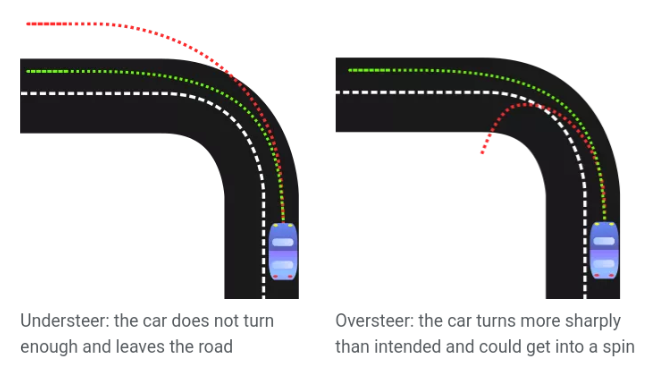Understeer and oversteer are vehicle dynamics terms used to describe the sensitivity of a vehicle to steering. Oversteer occurs when a car steers by more than the amount ordered by the driver. Contrarywise, understeer occurs when a car steers less than the amount ordered by the driver.
Automotive engineers express understeer and oversteer based on changes in steering angle related with changes in lateral acceleration over a sequence of steady-state circular turning tests. Car and motorsport enthusiasts often use the terminology more generally in magazines and blogs to describe vehicle response to steering in all kinds of maneuvers.
Vehicle dynamics terminology
The standard terminology used to describe understeer and oversteer are defined by the Society of Automotive Engineers (SAE) in document J670 and by the International Organization for Standardization (ISO) in document 8855. By these terms, understeer and oversteer are based on differences in steady-state conditions where the vehicle is following a constant-radius path at a constant speed with a constant steering wheel angle, on a flat and level surface.
Understeer and oversteer are defined by an understeer gradient (K) that is a measure of how the steering needed for a steady turn changes as a function of lateral acceleration. Steering at a steady speed is compared to the steering that would be needed to follow the same circular path at low speed. The low-speed steering for a given radius of turn is called Ackermann steer. The vehicle has a positive understeer gradient if the difference between required steer and the Ackermann steer increases with respect to incremental increases in lateral acceleration. The vehicle has a negative gradient if the difference in steer decreases with respect to incremental increases in lateral acceleration.
Understeer and oversteer are formally defined using the gradient “K”. If K is positive, the vehicle shows understeer; if K is negative, the vehicle shows oversteer; if K is zero, the vehicle is neutral.
Several tests can be used to determine understeer gradient: constant radius (repeat tests at different speeds), constant speed (repeat tests with different steering angles), or constant steer (repeat tests at different speeds). Formal descriptions of these three kinds of testing are provided by ISO. Gillespie goes into some detail on two of the measurement methods.
Results depend on the type of test, so simply giving a deg/g value is not sufficient; it is also necessary to indicate the type of procedure used to measure the gradient.
Vehicles are basically nonlinear systems, and it is normal for K to vary over the range of testing. It is possible for a vehicle to show understeer in some conditions and oversteer in others. Thus, it is essential to lay down the speed and lateral acceleration whenever reporting understeer/oversteer characteristics.
Contributions to understeer gradient
Many properties of the vehicle affect the understeer gradient, including tire cornering stiffness, camber thrust, lateral force compliance steer, self aligning torque, lateral weight transfer, and compliance in the steering system. Weight distribution affects the normal force on each tire and therefore its grip. These individual contributions can be acknowledged analytically or by measurement in a Bundorf analysis.
Automotive engineers express understeer and oversteer based on changes in steering angle related with changes in lateral acceleration over a sequence of steady-state circular turning tests. Car and motorsport enthusiasts often use the terminology more generally in magazines and blogs to describe vehicle response to steering in all kinds of maneuvers.
Vehicle dynamics terminology
The standard terminology used to describe understeer and oversteer are defined by the Society of Automotive Engineers (SAE) in document J670 and by the International Organization for Standardization (ISO) in document 8855. By these terms, understeer and oversteer are based on differences in steady-state conditions where the vehicle is following a constant-radius path at a constant speed with a constant steering wheel angle, on a flat and level surface.
Understeer and oversteer are defined by an understeer gradient (K) that is a measure of how the steering needed for a steady turn changes as a function of lateral acceleration. Steering at a steady speed is compared to the steering that would be needed to follow the same circular path at low speed. The low-speed steering for a given radius of turn is called Ackermann steer. The vehicle has a positive understeer gradient if the difference between required steer and the Ackermann steer increases with respect to incremental increases in lateral acceleration. The vehicle has a negative gradient if the difference in steer decreases with respect to incremental increases in lateral acceleration.
Understeer and oversteer are formally defined using the gradient “K”. If K is positive, the vehicle shows understeer; if K is negative, the vehicle shows oversteer; if K is zero, the vehicle is neutral.
Several tests can be used to determine understeer gradient: constant radius (repeat tests at different speeds), constant speed (repeat tests with different steering angles), or constant steer (repeat tests at different speeds). Formal descriptions of these three kinds of testing are provided by ISO. Gillespie goes into some detail on two of the measurement methods.
Results depend on the type of test, so simply giving a deg/g value is not sufficient; it is also necessary to indicate the type of procedure used to measure the gradient.
Vehicles are basically nonlinear systems, and it is normal for K to vary over the range of testing. It is possible for a vehicle to show understeer in some conditions and oversteer in others. Thus, it is essential to lay down the speed and lateral acceleration whenever reporting understeer/oversteer characteristics.
Contributions to understeer gradient
Many properties of the vehicle affect the understeer gradient, including tire cornering stiffness, camber thrust, lateral force compliance steer, self aligning torque, lateral weight transfer, and compliance in the steering system. Weight distribution affects the normal force on each tire and therefore its grip. These individual contributions can be acknowledged analytically or by measurement in a Bundorf analysis.


